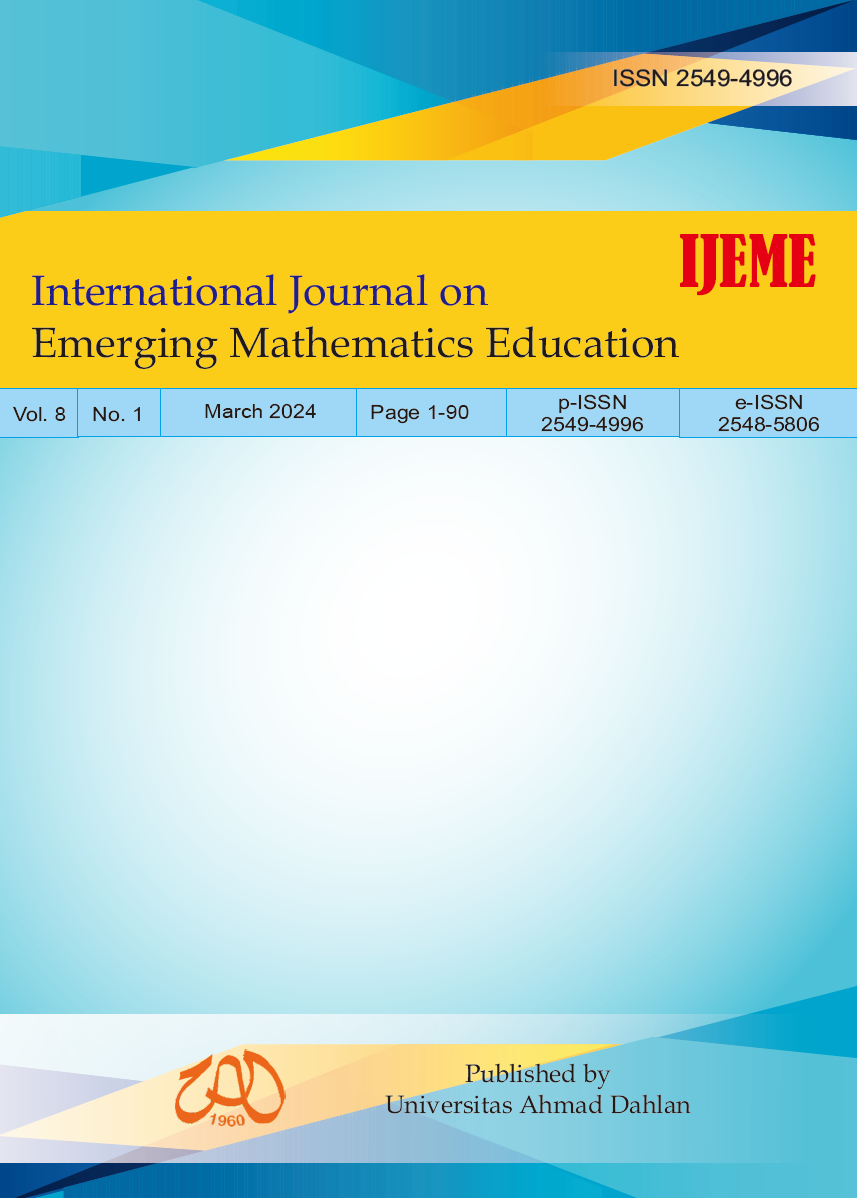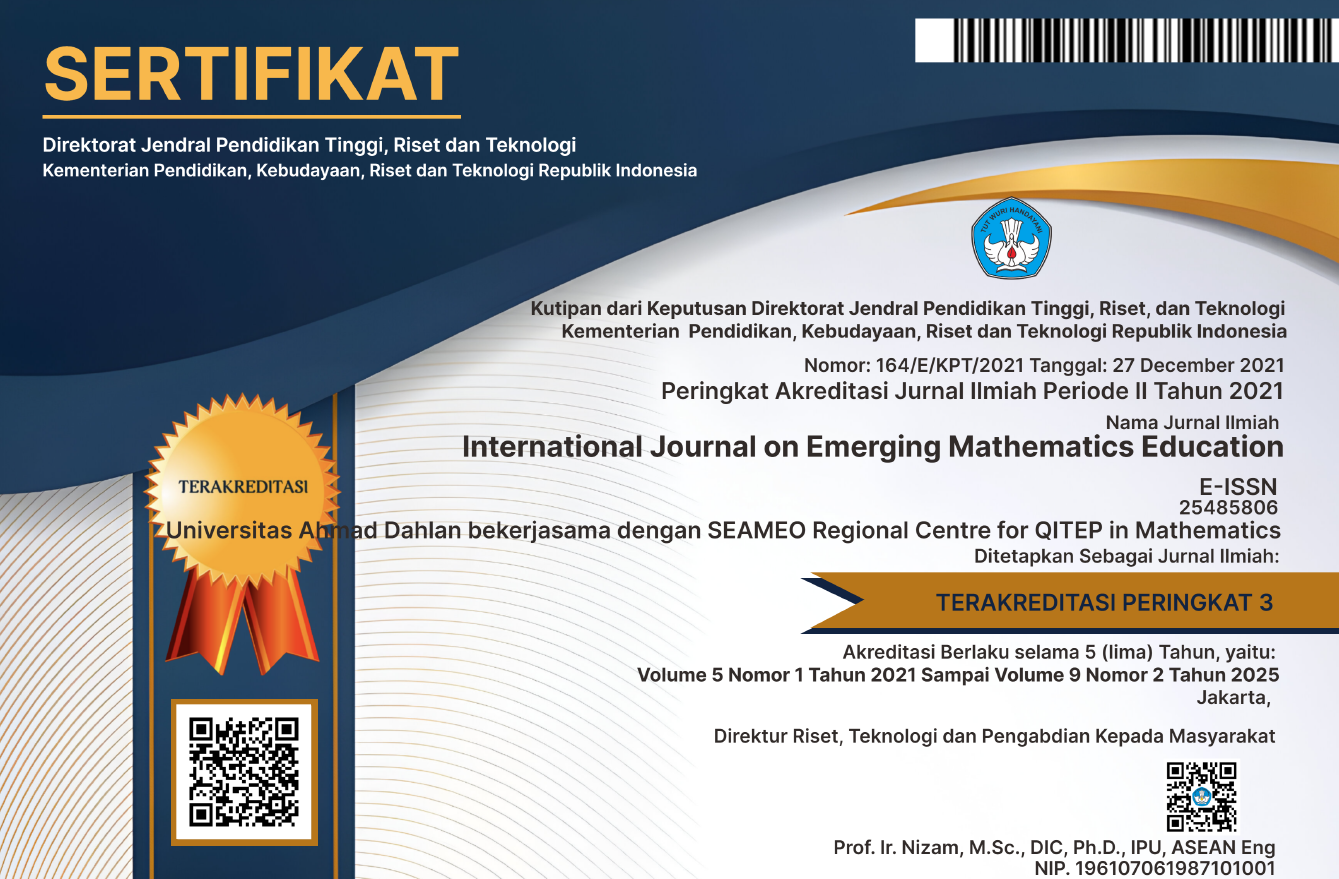Congruency of Generation Z Student’s Mathematics Self-Efficacy and Anxiety and Teacher’s Teaching Strategy
DOI:
https://doi.org/10.12928/ijeme.v7i2.27291Keywords:
Generation Z, mathematics anxiety and self-efficacy, teaching strategiesAbstract
This study emphasized the association between generation Z students’ mathematics anxiety and self-efficacy levels and the teaching strategies of mathematics senior high school teachers. The descriptive-correlational method was utilized and researcher-modified questionnaires to gather data of the 50 students. This study employed and utilized mean, standard deviation, z-test and Pearson r. The results showed that (1) the mathematics anxiety level of the students is high and self-efficacy is moderate, (2) the students’ self-efficacy level towards mathematics subject did not significantly affect their anxiety level, (3) senior high school mathematics teachers made use of differentiated instruction and/or strategies but did not significantly affect the anxiety level of the generation Z students, and (4) lecture/discussion, demonstration and project teaching strategies significantly affect the mathematics self-efficacy level of the students. In conclusion, although the generation Z students demonstrate a high mathematics anxiety yet their ability redirect with confidence to exert behaviors basically to produce clear performance accomplishments in mathematics. Finally, the researchers concluded that mathematics anxiety level is not about teacher’s strategy in the class but due to other reasons experienced (past) and developed by the generation Z students and there were conventional teaching strategies (lecture/discussion, demonstration, and project) that can influence mathematics self-efficacy of the students.References
Bahr, P. R. (2013). The aftermath of remedial math: Investigating the low rate of certificate completion among remedial math students. Research in Higher Education, 54(2), 171200. doi:10.1007/s11162-012-9281-4
Bantiding, Herminia A. (2019). Mathematics Anxiety, Ability and Performance among Second Year High School Students. Retrieved from: https://ejournals.ph/article.php?id=230.
Bhat, A. (2023). Descriptive Correlational: Descriptive vs correlational research. Retrieved from QuestionPro: https://www.questionpro.com/blog/descriptive-research-vs-correlational-research/#:~:text=Descriptive%20correlational%20research%20is%20a,is%20a%20link%20between%20them.
Canonizado, I. C. (2009). Why Do Some Pupils Find Math Hard? The Modern Teacher, 58(4).
Furner, J. M., & Duffy, M. L. (2002). Equity for all students in the new millennium: Disabling math anxiety. Intervention in School and Clinic, 38(2), 67-72.
Marin, K.A. & White, S.J. (2023). Generation Z goes to math class: How the effective mathematics teaching practices can support a new generation of learners. School Science and Mathematics, 31-37.
Mathematics Framework for Philippine Education (2011). The Science Education Institute, Department of Science and Technology (SEI-DOST) and the Philippine Council of Mathematics Teacher Education (MATHTED), Inc., Manila, Philippines.
Phan, H. P. (2012). Relations between informational sources, self-efficacy and academic achievement: A developmental approach. Educational Psychology, 32(1), 81-105. doi:10.1080/01443410.2011.625612
Scarpello, G.V. (2005). The effect of mathematics anxiety on the course and career choice of high school vocational-technical education students. Unpublished Doctor of Philosophy thesis, Drexel University. Retrieved from http://idea.library.drexel.edu/bitstream/1860/492/8/Scarpello_Gary.pdf
Wonu, Nduka Ebere (2014). The 21st Century Mathematics Education. Retrieved at http://www.datarmatics.comWalpole, R. E., Myers, R. H., & Ye, K. (2007). Probability & statistics for engineers & scientist. Pearson Education International.
Downloads
Published
How to Cite
Issue
Section
License
Copyright (c) 2024 Lister Matos Cabonilas

This work is licensed under a Creative Commons Attribution-ShareAlike 4.0 International License.
License and Copyright Agreement
In submitting the manuscript to the journal, the authors certify that:
- They are authorized by their co-authors to enter into these arrangements.
- The work described has not been formally published before, except in the form of an abstract or as part of a published lecture, review, thesis, or overlay journal. Please also carefully read the International Journal on Emerging Mathematics Education (IJEME) Author Guidelines at http://journal.uad.ac.id/index.php/IJEME/about/submissions#authorGuidelines
- That it is not under consideration for publication elsewhere,
- That its publication has been approved by all the author(s) and by the responsible authorities, tacitly or explicitly, of the institutes where the work has been carried out.
- They secure the right to reproduce any material that has already been published or copyrighted elsewhere.
- They agree to the following license and copyright agreement.
Copyright
Authors who publish with the International Journal on Emerging Mathematics Education (IJEME) agree to the following terms:
- Authors retain copyright and grant the journal the right of first publication with the work simultaneously licensed under a Creative Commons Attribution License (CC BY-SA 4.0) that allows others to share the work with an acknowledgment of the work's authorship and initial publication in this journal.
- Authors are able to enter into separate, additional contractual arrangements for the non-exclusive distribution of the journal's published version of the work (e.g., post it to an institutional repository or publish it in a book), with an acknowledgment of its initial publication in this journal.
- Authors are permitted and encouraged to post their work online (e.g., in institutional repositories or on their website) prior to and during the submission process, as it can lead to productive exchanges, as well as earlier and greater citation of published work.
![]()
Ciptaan disebarluaskan di bawah Lisensi Creative Commons Atribusi-BerbagiSerupa 4.0 Internasional.





